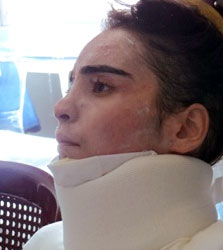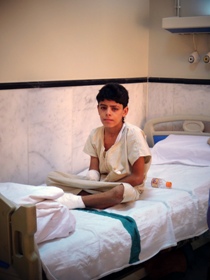 Geography student, Jinan, suffers from severe burns on her arms, legs, neck and chest after a massive explosion near her home in Damascus. She is currently being treated at al-Mouwassat hospital. Photo credit: WHO/Syria17 September 2013 – "I’ll be home in a couple of minutes’, she said on the phone. A moment later, I heard the explosion and I knew she was close to the place of impact," recalls the mother of Jinan, a 20-year-old geography student at Damascus University. “I ran out of the house to look for her, but the security guards did not allow me to enter the scene. I was devastated.”
Geography student, Jinan, suffers from severe burns on her arms, legs, neck and chest after a massive explosion near her home in Damascus. She is currently being treated at al-Mouwassat hospital. Photo credit: WHO/Syria17 September 2013 – "I’ll be home in a couple of minutes’, she said on the phone. A moment later, I heard the explosion and I knew she was close to the place of impact," recalls the mother of Jinan, a 20-year-old geography student at Damascus University. “I ran out of the house to look for her, but the security guards did not allow me to enter the scene. I was devastated.”
In 2011, at the beginning of the Syrian conflict, Jinan’s family left its home in the heavily affected area of Mouadamiya near Damascus, and moved to the centre of the capital looking for safety.
But three months ago, Jinan’s arms, legs, neck and chest were severely burned in a massive explosion. She spent the first week at the intensive care unit of al-Mouwassat hospital—the main referral hospital operated by the Syrian Ministry of Higher Education. She is currently receiving treatment for severe burns, and in the coming months will undergo numerous operations, mainly skin grafts. “Her right arm is cruelly lacerated,” says her mother. She keeps telling me, "I don’t like my arm, please cut it off!’”
A burn is an injury to the skin or other tissue caused by heat or radiation, radioactivity, electricity, friction or contact with chemicals. Globally, burns occur most commonly in the home and workplace. In Syria, however, more and more people, including very young children, are being burnt in conflict-related explosions. Hospitals being are overwhelmed with burns patients and face severe shortages in medical supplies and medicines.
The situation prompted the World Health Organization (WHO) to support the establishment of the country’s first specialized burns unit at al-Mouwassat hospital, in July 2013.
Children affected
Al-Mouwassat hospital receives between 15 and 17 burns cases each week. “The number of burns patients has increased since the beginning of the conflict,” says Dr Khalid, head of the new unit. “The high volume of patients resulted in insufficiency in medicines and medical supplies.”
Another victim of burns in al-Mouwassat hospital is 11-year-old Maher, originally from the city of Qamishli in north-eastern Syria. “Suddenly, heavy mortar shelling started to fall on the village. Three of them struck our house while the kids were playing in the front yard,” Maher’s father said.
After agonizing moments of searching, he finally found Maher, his face covered with blood. “His left eye was gone and his right arm was severely injured. It had to be amputated.” A month later, after the family moved to the capital, Maher was admitted to al-Mouwassat hospital for treatment.
In addition to six intensive care unit (ICU) beds and two ICU ventilators, WHO has provided specialized burn kits, life-saving medicines, equipment and medical supplies to meet the needs of 15 000 people suffering from burns.
Across Syria, the health situation continues to deteriorate with shortages of medicines and medical workers, destruction of health facilities and difficulties in accessing health care.
In the first seven months of 2013, UN and nongovernmental health agencies in Syria provided emergency medical supplies to treat more than 2 million people, under the leadership of WHO. More than 3.7 million people have been reached with health services, medicines or other medical supplies.
 11-year-old Maher from Qamishli was playing with his friends when a heavy mortar shelling fell on his village. He lost his left eye and his right arm was severely injured.However, with only half of the necessary funds available and the escalation of violence, WHO and partners are struggling to provide basic health services to everyone. Jinan and Maher can only hope that they will soon recover and find their place in a more peaceful Syria.
11-year-old Maher from Qamishli was playing with his friends when a heavy mortar shelling fell on his village. He lost his left eye and his right arm was severely injured.However, with only half of the necessary funds available and the escalation of violence, WHO and partners are struggling to provide basic health services to everyone. Jinan and Maher can only hope that they will soon recover and find their place in a more peaceful Syria.




